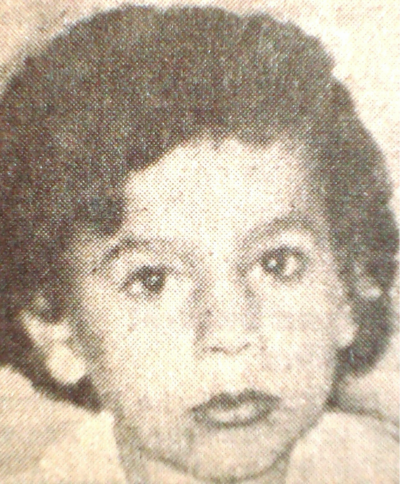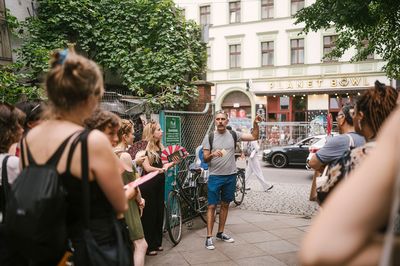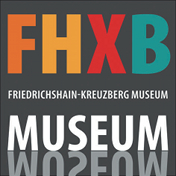
Ceremonial naming of the Çetin Mert Park
11th May | 3 pm | Green Space Skalitzer Str./Mariannenstr.
Çetin Mert (1970-1975) lived with his family in Kreuzberg. His mother Münevver was one of the first migrant workers to come to West Berlin from Turkey. On his 5th birthday, May 11, 1975, Çetin was playing on what was then Gröbenufer (now May-Ayim-Ufer) near Oberbaumbrücke when he fell into the Spree and drowned. The full width of the Spree belonged to East Berlin and entering the border area was life-threatening. He could not be rescued. Çetin Mert was one of the youngest victims of the division of Berlin (1961-1989). Before he died, four children had already drowned near the Oberbaum Bridge. After his death, there were protests by Berliners of Turkish origin. In October 1975, the Senate and the GDR government signed an agreement on rescue measures in the event of accidents in Berlin's border waters. To prevent further accidents, a fence was erected on the banks of the Gröbenufer.
T The following spoke: Clara Herrmann (District Mayor Friedrichshain-Kreuzberg), Anna von Arnim-Rosenthal (Berlin Wall Foundation, Director of the East Side Gallery), Dr. Jens Schöne (Deputy Berlin Commissioner for the Reappraisal of the SED Dictatorship, BAB), Safter Çınar (Board Spokesman Turkish Federation in Berlin-Brandenburg). Musically framed by: Encan Acıkada.

Film evening “Mein Kiez. History(s) of the divided Berlin”
16th May | 6 pm | Roof top FHXB Museum
As a film student in 1991, Can Candan interviewed migrants of Turkish origin from Kreuzberg: What did the fall of the Wall mean for them and their everyday lives? What fears and hopes did they associate with it? How did they deal with the flare-up of racism?
In “Walls 2.0”, authors Jana König, Elisabeth Steffen and Inga Turczyn interview some of the participants in “Duvarlar” again: How do they view issues such as racism, nationalism and economic exploitation today? Are there new 'walls'? People from the eastern part of Berlin also have their say.
“Duvarlar - Mauern - Walls” (D, 2000), directed by Can Candan
Excerpts from the film “Walls 2.0 - migrant and anti-racist perspectives on the fall of the Wall” (D, 2011)
Film talk
Pia Eiringhaus, Curator Outreach at the Berlin Wall Foundation
Jana König, Head of Collection at the FHXB Museum
Inga Turczyn, freelance author and director for documentary film
Moderation: Nora Hogrefe, Head of the Coordination Office for Historical City Markings, Active Museum
Free admission
Reading in German spoken language
Wheelchair-accessible
A cooperation between the Berlin Reappraisal Commissioner and the FHXB Friedrichshain-Kreuzberg Museum.
Further information at
https://www.berlin.de/aufarbeitung/mein-kiez/artikel.1421814.php

Lange Woche der Kiezgeschichte: Stadtführungen in Kreuzberg und Friedrichshain am 25. Mai, 29. Mai und 1. Juni
Stadtrundgang 1:
Migrantische Selbstorganisation gegen Rassismus und Faschismus
Samstag, 25.05., 13 Uhr
Treffpunkt: Garten des FHXB Museums
Beim Stadtrundgang am Kottbusser Tor, dem Knotenpunkt von Kreuzbergs Migration geprägter Geschichte seit den 1960ern, erkunden wir gemeinsam Orte sozialer Dynamik migrantischer Selbstorganisation und des Widerstands gegen Rassismus und Faschismus. Eine Reise durch Zeit und Raum, die uns die Kraft der Solidarität und des politischen Engagements in Kreuzberg näherbringt.
Anmeldung erforderlich
Kontakt: veranstaltungenfhxb-museum.REMOVE-THIS.de
Stadtrundgang 2: Der 17. Juni 1953 in Friedrichshain
Mittwoch, 29.05., 17 Uhr
Treffpunkt: Frankfurter Tor an der Treppe vor der Kneipe „Brewdog“
Vor 71 Jahren kam es am 17. Juni zum landesweiten Volksaufstand in der DDR. Im Stadtteil Friedrichshain gibt es rund um die ehemalige Stalinallee zahlreiche biographische und geographische Bezüge, die es bei dieser Stadtführung zu entdecken gibt.
Anmeldung erwünscht
Kontakt: Tom-Aaron Aschke, tomaaron.aschkegmail.REMOVE-THIS.com
Stadtrundgang 3: Kraftwerk, Klavierpest und Kohleberg. Eine Konsum- und Umweltgeschichte Kreuzbergs
Samstag, 01.06., 13:30 Uhr
Treffpunkt: Ohlauer Str./Paul-Lincke-Ufer
Umweltgeschichte widmet sich den vielen Wechselwirkungen zwischen Mensch und Umwelt. Der Kampf gegen Mikroben wird uns bei dem Stadtrundgang ebenso beschäftigen wie der Wandel der Haushaltsführung und unsere Rolle als Konsument*innen. Auch die vielen Kämpfe der Berliner*innen für Volksparks, Radwege und eine lebenswerte Umwelt werden wir verfolgen.
Anmeldung erwünscht






